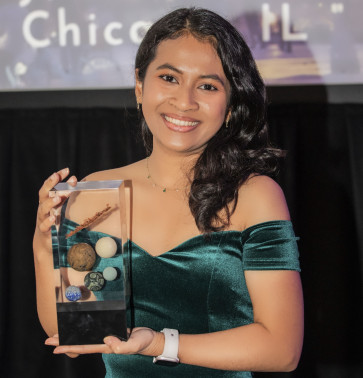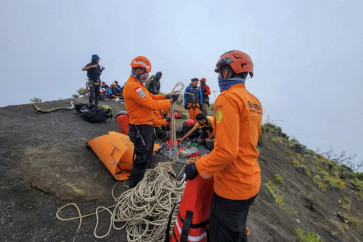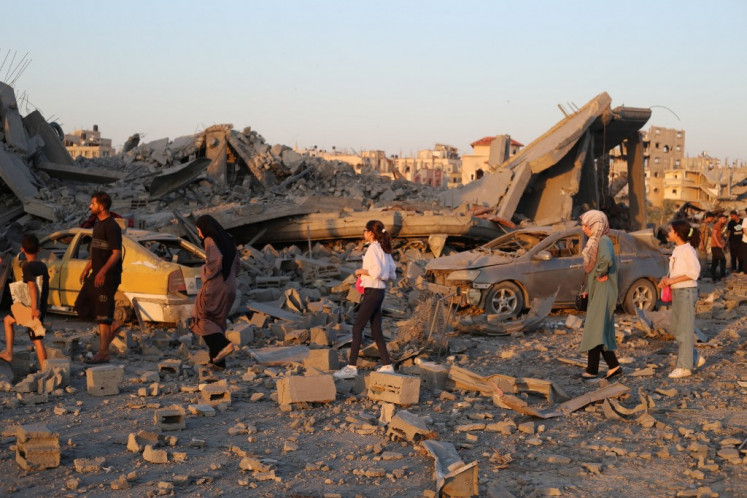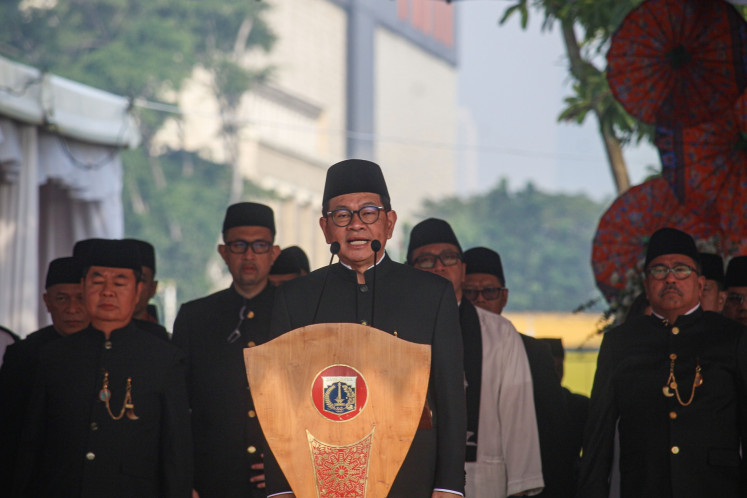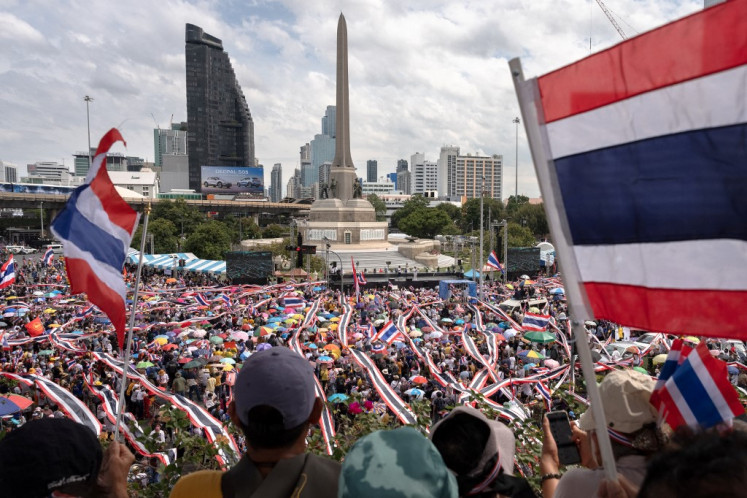Popular Reads
Top Results
Can't find what you're looking for?
View all search resultsPopular Reads
Top Results
Can't find what you're looking for?
View all search resultsSwiss Community: Nestlé Indonesia: Building competitive advantage on thriving society
PT Nestlé Indonesia’s President Director Dharnesh Gordhon (JP/Arief Suhardiman)Building sustainable business practices is as important as developing product innovations
Change text size
Gift Premium Articles
to Anyone

PT Nestlé Indonesia’s President Director Dharnesh Gordhon (JP/Arief Suhardiman)
Building sustainable business practices is as important as developing product innovations. A well-rounded business strategy is the secret behind Nestlé’s 150 years of being a market leader.
It is hard for Indonesians to live without Nestlé products. From Dancow milk powder and Bear Brand milk to Nescafé and Kit Kat, its products are part of Indonesians’ day-to-day life.
Nestlé set a footprint in Indonesia almost a hundred years before PT Nestlé Indonesia was established on March 29, 1971 (then still known as PT Food Specialties): the famous condensed Cap Nona (old Indonesian spelling: Tjap Nona) milk entered the Indonesian market in 1873 as the local version of the company’s Milkmaid product. Indeed, Cap Nona condensed milk is still part of our lives today as it is one of the most famous local brands of the category.
As the largest food and beverage company in the world with more than 2,000 global brands across 191 nations around the world, Nestlé itself has a long history. It started with the establishment of the Anglo-Swiss Condensed Milk Company in 1866. Henri Nestlé then invented a breakthrough infant food in 1867 to save the life of a premature baby who could not accept breastmilk. He later merged his company with the Anglo-Swiss group in 1905 to found what we know today as the Nestlé Group.
“You have to remember that although the company originated from Switzerland, we are an Indonesian company. We have a long heritage here; in 1873 our first product entered the country and in 1971 we established our company as an Indonesian limited liability company when the country opened for foreign investment, and in 1973 we started to produce our products in the country,” PT Nestlé Indonesia President Director Dharnesh Gordhon told The Jakarta Post in a recent interview in Jakarta.
During many decades of operating in Indonesia, the company has been successful in creating what Dharnesh referred to as “uniquely Indonesian brands” such as Dancow and has made Bear Brand milk as one of many very popular products among Indonesian consumers.
Besides being an important market for Nestlé, Indonesia’s resources have apparently played an important role in helping the company manufacture its products.
Take the world-famous Nescafé soluble coffee, for instance, a Nestlé product that is sold in Europe, Japan, South Korea and many other countries. “We are very pleased that the high quality coffee beans produced by the coffee farmers partner in Lampung have been exported to some countries to produce the Nescafé soluble coffee products. We are also very proud to say that all Nescafé products produced in our Panjang Factory, Bandar Lampung, is using 100% Lampung coffee beans,” Dharnesh said. He also further stated how Nestlé is working closely with dairy farmers, cocoa farmers and red rice and soya bean farmers that supply their produce, and is currently working with about 56,000 farmers across Indonesia.
Business strategies
To survive for more than 150 years as a global market leader and to help its business thrive locally for decades, Nestlé believes that these cannot be achieved just by selling products: they have to have a long-term commitment to build sustainable business practices in the country where they operate.
The commitment is translated into financial investments for capital expenditure, sales and marketing, community empowerment, transfer of technology and capacity building both for its employees and other stakeholders.
The company also provides direct employment to around 3,500 people in Indonesia. In terms of indirect economic impact, the company has over 200 distributors across the country and thousands of suppliers that also provide significant employment opportunities along its value chain, Dharnesh said.
This is where the company’s underlying philosophy of “creating shared value” (CSV) comes into play. “Creating shared value is our way of doing business. We teach farmers how to improve the yield of their products, how to use the right pesticide, how to grow the business, what the better farming practices are and how to become a quality supplier, and all these activities are parts of our business strategy. All these activities can be sustained in the long term,” he said.
Dharnesh further continued with how this strategy is used to bring Nestlé’s purpose to life – to enhance quality of life and contribute to a healthier future.
“Driven by our purpose, Nestlé globally has defined three ambitions, which also support the achievement of Sustainable Development Goals in 2030. These are helping 50 million children lead healthier lives, helping to improve 30 million livelihoods in communities where we do our business and striving for zero environmental impact in our operations,” Dharnesh said.
As such, the company has actively involved itself in creating public awareness on the importance of good nutrition and a healthy lifestyle, which includes a nutritionally balanced diet and regular exercise.
“We conducted a nutrition landscape study at the end of last year to know, for example, what are the main health problems among Indonesian children and adults? We discovered that malnutrition, stunting, micronutrient deficiency, obesity and the gap in good nutrition knowledge are still significant problems in the country. So our challenge is how to help the government to address such issues. We have committed to fortify our products with micro-nutrients such as vitamin A, D and iodine, to reduce salt, sugar and trans fat content in our products while also ensuring that our products are still giving the same pleasure, and also to provide nutrition education through our various programs,” he said. He also further explained the company’s brand positioning of offering healthier and tastier food and beverage choices.
For product development, the company is relying heavily on research and development, which helps it to constantly innovate and address business challenges and competition. To date, the company has the largest food research center in the world, employing about 5,000 scientists focusing on nutrition and health.
Nestlé itself has over 40 research centers for specific product categories across the world, including in Switzerland, France, Singapore, China, the United States and Japan. The research and development team in Switzerland is devising the company’s innovations, looking forward to trends that will happen in the next 20 years.
“We have to be very competitive and based on our R&D, we have to take the idea and commercialize it to benefit consumers and at the same time to be ahead of the competition. The marketplace is constantly changing and if we don’t respond quicker, we will be left behind. We want to continue to be a market leader,” Dharnesh said.
Challenges and opportunities
In a country with promising opportunities like Indonesia, and with its total population of more than 260 million people, stable economic growth and also a flourishing middle-class demography, a company like Nestlé has the opportunities to develop its businesses while at the same time contribute to the society.
“We have just recently signed a memorandum of understanding with the Lampung provincial government to support Lampung coffee farmers through the placement of Lampung’s traditional logo, the Siger Lampung, on the packaging of our Nescafé Classic products,” Dharnesh said, explaining the company’s effort to help popularize robusta Lampung coffee beans. “We strongly believe that to enable us to survive in the business, we have to act as a local, and this is reflected in the way we respect the culture, value and people, and at the same ensuring our compliance to the laws and regulations,” he added.
When asked about the company’s future plans, Dharnesh mentioned the potential of the beverage market in Indonesia. “People are getting more urbanized here, with both men and women working, with more disposable income. Therefore, many people are looking for more convenience in terms of consumption. As such, the beverage market also comes up with new trends to be part of the solution. This is where we seek to strengthen our presence.”
“Indonesia is the fifth largest coffee market and yet we are not a coffee market leader in Indonesia. Therefore, we will give more focus in the coffee category in order to compete here,” Dharnesh said in closing.

